If you’ve ever purchased potted plants or veggie starts, or opened a bag of commercial potting mix, you may have noticed tiny white balls in the soil that look like Styrofoam bits.
These white balls are actually important soil components called perlite, and they’re not simply fillers or artificial rocks as some people might believe.
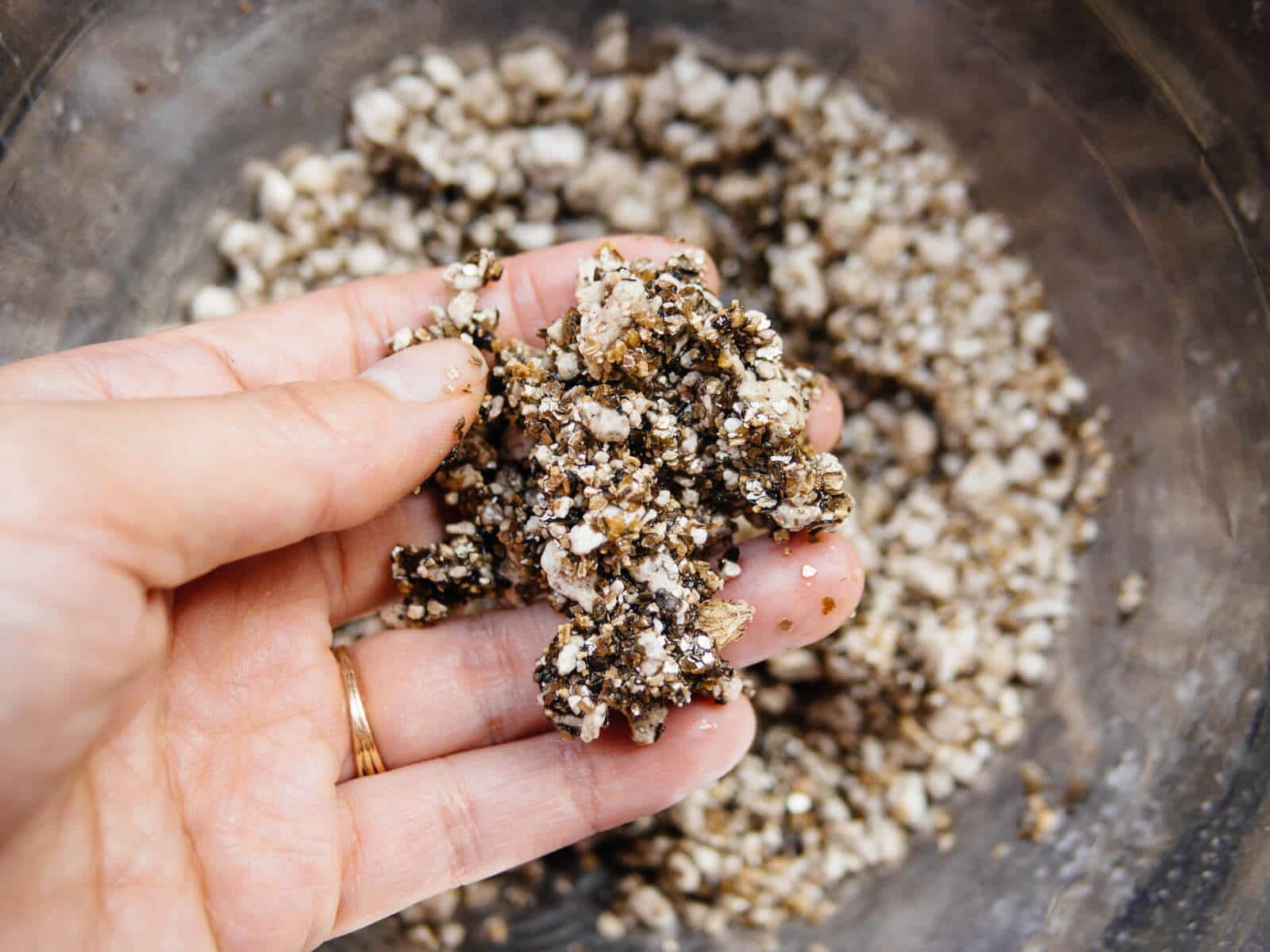
What is perlite?
First, let’s go over what perlite isn’t: Perlite is not a type of soil, it’s a soil additive that can also be used as a growing medium.
Perlite is not a fertilizer, and has no nutritional or microbial value to plants or soil. Its benefits are derived solely from keeping the soil structure loose and light.
What perlite is: an inorganic, non-toxic, lightweight soil amendment. But don’t let the “inorganic” part dissuade you if you’re an organic gardener! (More on that below.)
Also known as expanded pyrite, perlite is a mined volcanic rock that is mixed into many industrial building products for stability, such as masonry construction, loose-fill insulation, cement, and plaster.
It’s also used as filter media for swimming pool filters, and as a filter aid for beverages (like juices, beer, and wine) and for waste water.
In the gardening world, perlite is used to improve soil structure by providing drainage and aeration. “Air for the soil” is what I like to call it, and it’s the next best thing to compost for circulating air between the roots for strong, healthy plant growth.
Look under a microscope and you’ll find that perlite is filled with many tiny cavities that hold water (like a sponge), making it efficient at delivering moisture to plant roots. All these nooks and crannies enable perlite to hold three to four times its weight in water.
It’s also capable of storing nutrients for a short period when they otherwise might wash away immediately.
At the same time, the cavities mean perlite is quite porous, so it drains excess water more readily than vermiculite and other potting media. This is a good thing, since keeping your soil from becoming waterlogged is the number-one way to prevent root rot and fungal diseases.
Disclosure: If you shop from my article or make a purchase through one of my links, I may receive commissions on some of the products I recommend.
Is perlite organic?
To call something organic depends on your personal beliefs (and here, it’s merely a case of semantics).
From a chemistry perspective, organic compounds contain carbon. Since perlite does not contain carbon, it’s considered an inorganic material.
But from a gardening perspective, the term “organic” refers to something that is naturally produced without synthetic processes or significant chemical changes.
It’s true that perlite has to be “popped” in an industrial process that turns it into the lightweight material we see and know, but it is still a naturally occurring mineral that’s extracted from the earth.
It’s no different from seaweed emulsion or fish fertilizer that has to undergo some kind of process to be suitable for gardening.
And officially, horticultural perlite is OMRI listed for use in organic agriculture, so you don’t need to worry about what you’re putting in the ground.
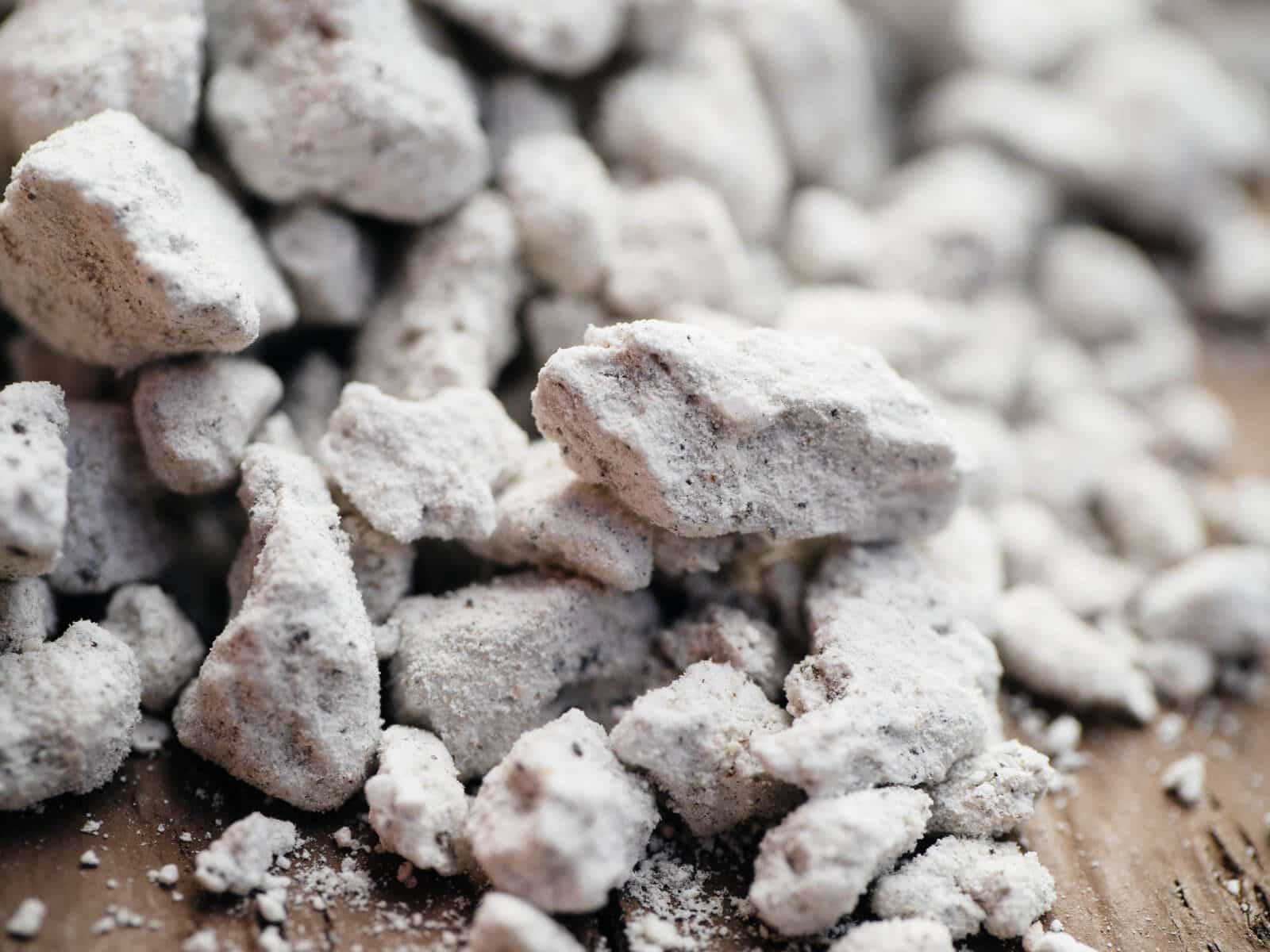
How is perlite made?
The perlite we see in potting mixes is often called “volcanic popcorn,” and for good reason.
Straight out of the ground, perlite is a dense, amorphous volcanic glass with very high water content. In its natural state perlite is brown or black in color, as it’s typically formed during the cooling process of lava that produces obsidian.
During processing, raw perlite is superheated very rapidly to temperatures of 1560°F to 1650°F, which causes the material to soften and the moisture inside the glass to turn to steam. As the trapped moisture inside bubbles, trying to escape, it expands the material from 7 to 16 times its original size—much like popcorn popping.
The expanded material turns white due to the reflectiveness of the trapped bubbles, and the resulting perlite is a chemically inert, sterile material that takes on an ultra lightweight, foamy texture.
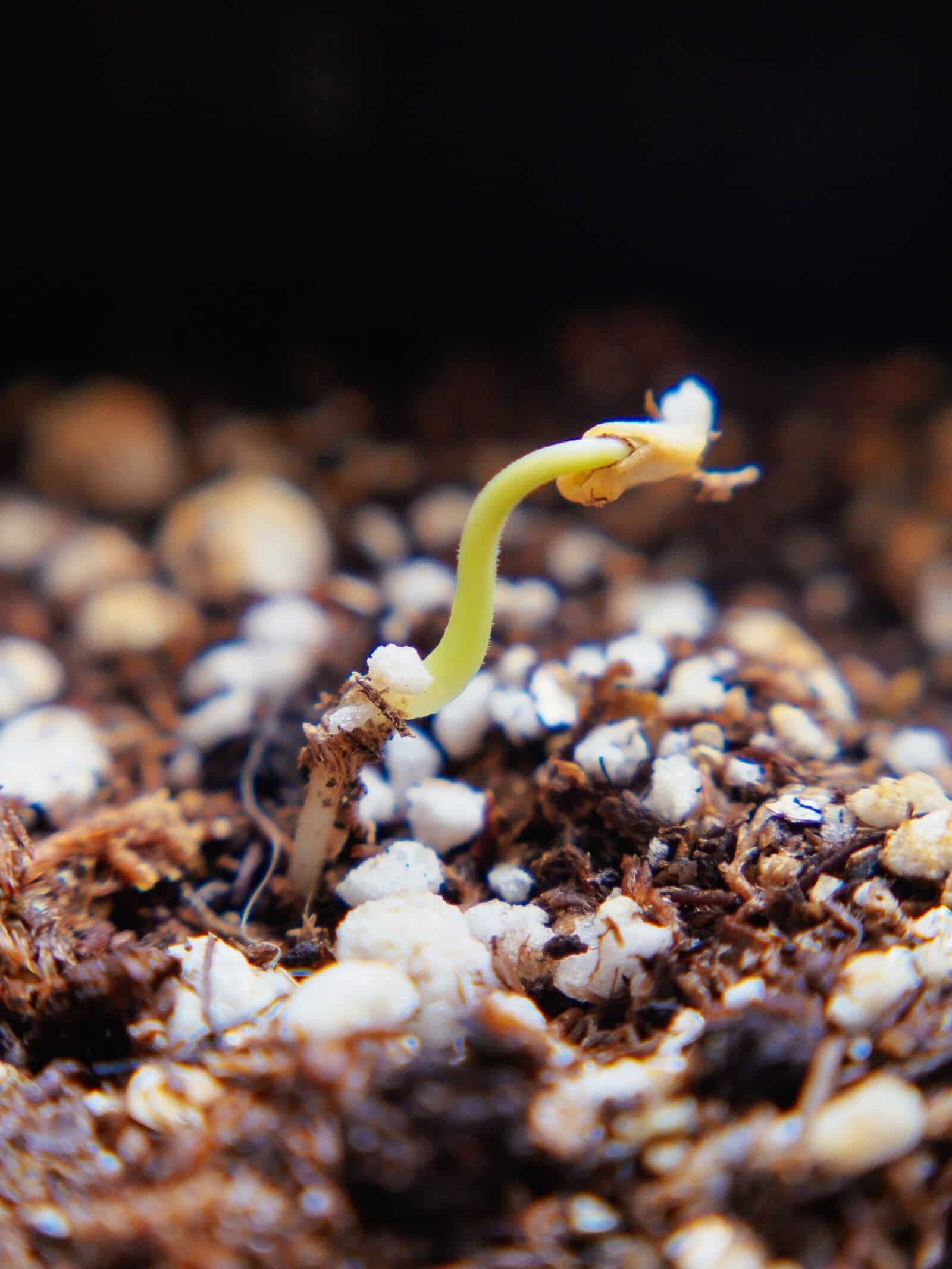
How to use perlite in the garden
Perlite is commonly used in potting soil and soilless mixes (particularly for indoor seed starting) to keep the soil structure loose and well-draining without risk of compaction over time.
You can combine equal parts perlite, vermiculite, and peat moss (or coco coir) for a clean, basic seed starting mix that supports healthy seedling development and reduces damping off disease.
You can also use it to propagate plant cuttings. Rather than just rooting your cutting in water, you can root it in a small jar filled with moistened perlite.
The same goes for seeds: start them in moistened perlite only, or test the germination of older seeds in baggies filled with moistened perlite (as an alternative to the coffee filter method of starting seeds).
In raised beds or in-ground garden beds that have trouble with cakey clay soil, you can improve drainage by raking in a 2-inch layer of perlite into the top 6 to 12 inches of soil, at the same time you amend the soil with compost and other nutrients.
Because it doesn’t break down, a single application of perlite can keep the planting bed light and loose for several years! It was my “secret ingredient” during my years of gardening in Southern California, when I needed something more than just compost to break up all the hard dirt clods in our beds.
Some (but not all) bagged potting and garden soils also benefit from having more perlite added to the mix.
This is especially beneficial for deep-rooted plants that are more productive when the roots don’t have to drive down into dense, compressed soil (think root vegetables like carrots and daikon—you’ll see how my previous clay soil was notorious for turning out silly, topsy-turvy carrots).
I also like adding extra perlite to my garlic planting beds in fall, as the perlite helps keep bulbs from being waterlogged in winter and spring. Perlite also helps the soil dry out in the week or two before your garlic crop is ready for harvest.
Perlite is an essential soil conditioner that I always keep on hand, and I buy a few bags every year as I always find a use for it.
Be aware that smaller grades of perlite, and in some cases cheap perlite with little quality control, can get dusty (especially as you get to the bottom of a bag).
If you’re sensitive to fine particles in the air, be sure to wear a dust mask and glasses when you’re handling perlite. (I like to keep both of these items in my garden toolkit when handling dusty materials like perlite or diatomaceous earth.)
Grades or sizes of perlite
Perlite is typically available in four grades or granule sizes, which correspond to coarseness levels.
| Type of Perlite | Grade | Granule Size |
|---|---|---|
| Super coarse perlite | #4 | 1 inch |
| Coarse perlite | #3 | 1/2 inch |
| Medium perlite | #2 | 1/4 inch to 3/8 inch |
| Fine perlite | #1 | 1/8 inch |
Super coarse and coarse perlite: This type of perlite is often used to amend raised beds and garden beds, or dense soils with high water-holding capacity (clay). Size #4 perlite is a whopper of a particle that should only be used for extremely heavy soil.
Medium perlite: You’ll mostly see medium-grade perlite in commercial potting soil. It’s a good all-around size for potted plants, window boxes, and general garden use.
Fine perlite: These smaller particles are ideal for starting seeds or rooting cuttings. Fine perlite is tough to find in this size as a standalone product, so I tend to go with fine pumice, which is usually labeled for bonsai or succulent planting.

Benefits of using perlite in the garden
Perlite is a highly useful component of gardening for many reasons:
- It is physically stable and retains its shape, even in heavy or saturated soil.
- It doesn’t decompose, so it’s ideal for use in potting mixes for plants that are repotted infrequently (such as succulents and other houseplants).
- It has a neutral pH level, making it suitable for any container or garden bed.
- It contains no toxic chemicals or additives; when you buy a bag labeled as perlite, that’s exactly what you’re getting.
- It’s able to absorb some water while letting the rest of it drain freely.
- It provides excellent aeration. Plants actually absorb 98 percent of their oxygen through the roots, so good aeration is crucial for healthy root development. Proper airflow also supports earthworms, beneficial nematodes, and other good things in the soil food web, which in turn supports plant life.
Because of these properties, perlite is also popular in orchid, cactus, and succulent planting mixes that like to be on the drier side, and in hydroponic setups as a standalone growing medium.
Does perlite cause fluoride burn in plants?
There’s a rumor that perlite is responsible for fluoride burn in houseplants, which appears as brown leaf spots or scorched leaf tips in susceptible plants like dracaena, spider plants, and Easter lilies.
If you’re using a commercial potting soil that contains perlite, however, the chances of that happening are very slim.
Fluorine toxicity can be caused by many things, including fluoridated water, superphosphate fertilizers, low soil pH, and other environmental conditions that have little to do with potting medium that simply has perlite in it.
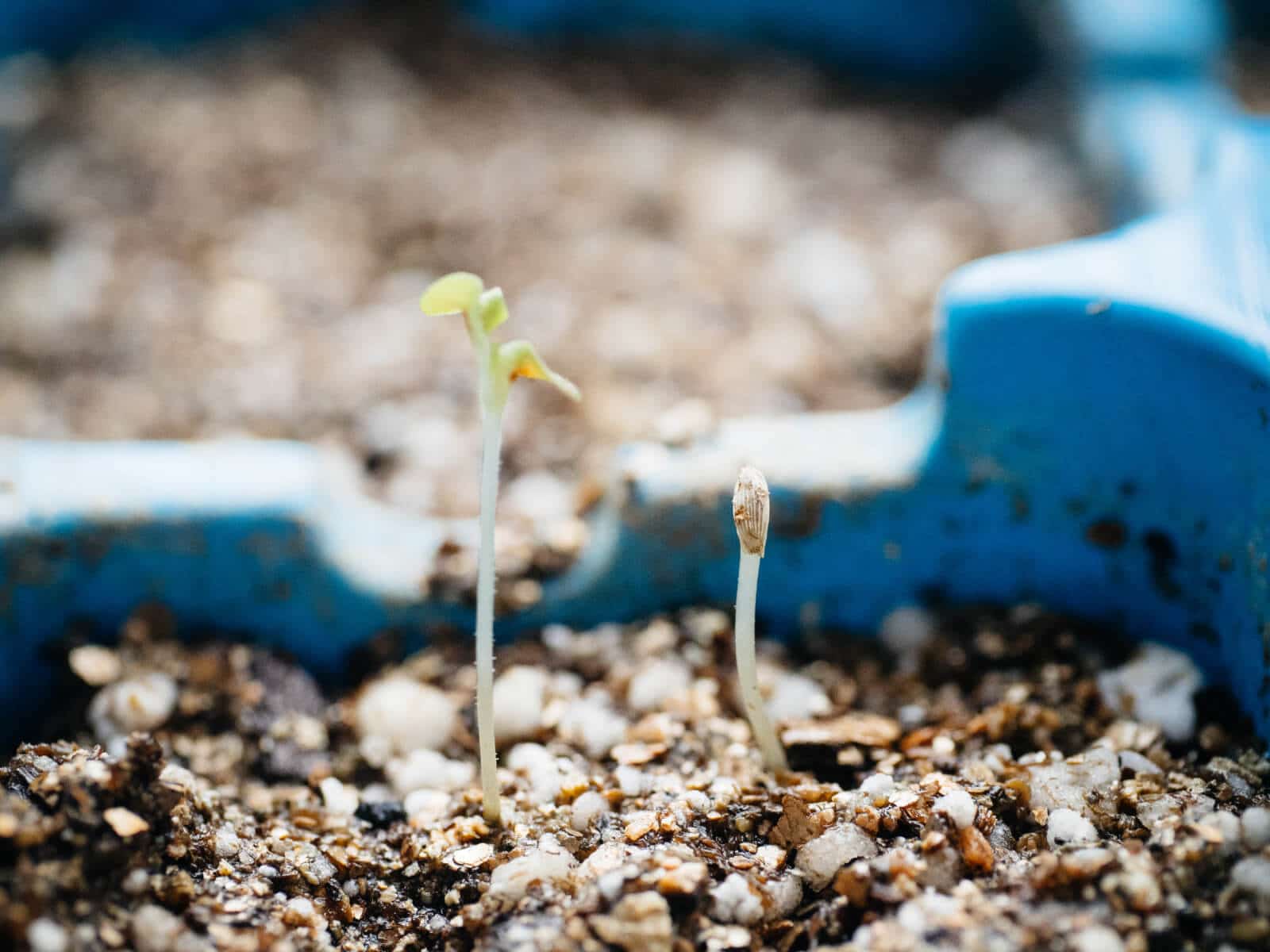
Where to buy perlite
The most convenient source of perlite is your local independent garden center or big-box plant nursery. When buying perlite, make sure you are buying 100 percent perlite and not a soil or soilless blend.
I’ve also linked my favorite brands of perlite (below) in a variety of sizes, which you can easily buy online.
If you can’t find perlite locally, pumice makes a good substitute as it has similar qualities. Sometimes you can use vermiculite in a pinch (especially as a seed starting medium), but keep in mind it retains more moisture than perlite does.
When it comes down to it, perlite is still the best choice for a soil amendment when you want moderate water retention, excellent aeration and drainage, and long-term benefits.
Perlite sources:
[show_shopthepost_widget id=”3911147″]
General Pumice Products 3.5-Gallon Bag 1/8-Inch General Garden Pumice | Black Gold 8-Quart Perlite | Hoffman 18-Quart Medium Horticultural Perlite | Espoma 1-Cubic Foot Organic Perlite | Viagrow 4-Cubic Feet Perlite | GROW!T 4-Cubic Feet Medium Coarse #2 Perlite | Mother Earth 4-Cubic Feet Coarse #3 Perlite | Mother Earth 4-Cubic Feet Super Coarse #4 Perlite | Vokproof Reusable Gardening Mask | Guoer Reusable Dust Mask | NoCry Safety Glasses With Clear Wraparound Lenses | NoCry Over-Glasses Safety Glasses
Common questions about perlite
What is a good substitute for perlite?
Pumice (another mined mineral) and rice hulls (the hard outer coverings of rice grains) are both good alternatives to perlite, as they work in the same way to aerate soil.
What is a good substitute for perlite?
Pumice (another mined mineral) and rice hulls (the hard outer coverings of rice grains) are both good alternatives to perlite, as they work in the same way to aerate soil.
Can you use pumice instead of perlite?
You bet! If you can’t find perlite, pumice is a popular 1-to-1 substitute. A benefit of pumice is that it’s heavier, so it doesn’t float or blow away as easily as perlite. Pumice also works well in potting mixes for taller plants that might need a little extra weight on the bottom to keep them from toppling over.
What is a good substitute for perlite?
Pumice (another mined mineral) and rice hulls (the hard outer coverings of rice grains) are both good alternatives to perlite, as they work in the same way to aerate soil.
Can you use pumice instead of perlite?
You bet! If you can’t find perlite, pumice is a popular 1-to-1 substitute. A benefit of pumice is that it’s heavier, so it doesn’t float or blow away as easily as perlite. Pumice also works well in potting mixes for taller plants that might need a little extra weight on the bottom to keep them from toppling over.
Can you use Styrofoam instead of perlite?
Don’t do this at home! (Or anywhere, for that matter.) Despite how similarly it looks and behaves compared to perlite, Styrofoam is not the kind of material you want to add to your garden permanently (especially an edible garden).
As it sits in the soil, Styrofoam will leach microscopic styrenes and other harmful chemicals that linger for centuries, and you’ll never get rid of it in your environment.
How much perlite should I add to my soil?
Depending on your plant’s needs, a good place to start is having the perlite make up around 10 percent to 30 percent of the total volume of your potting mix.
If you’re trying to break up hard clay soil in a garden bed, I recommend raking a 2-inch layer of perlite into the top 6 to 12 inches of soil, then add 2 to 3 inches of quality compost and see how it goes from there.
Remember that perlite doesn’t decompose, so once you add it, you’re permanently changing the structure of your soil. It’s better to start with a little and add more over time as needed.
Can you grow plants in just perlite?
Perlite is an excellent medium for indoor seed starting (when seedlings are prone to damping off) and for propagating cuttings, since it provides the perfect balance of moisture retention and drainage.
For smaller seeds, I recommend using finer grades of perlite; though for seeds that need light for germination, you can step up to a medium-coarse perlite that will let the sun shine through.
What is a good substitute for perlite?
Pumice (another mined mineral) and rice hulls (the hard outer coverings of rice grains) are both good alternatives to perlite, as they work in the same way to aerate soil.
Can you use pumice instead of perlite?
You bet! If you can’t find perlite, pumice is a popular 1-to-1 substitute. A benefit of pumice is that it’s heavier, so it doesn’t float or blow away as easily as perlite. Pumice also works well in potting mixes for taller plants that might need a little extra weight on the bottom to keep them from toppling over.
Can you use Styrofoam instead of perlite?
Don’t do this at home! (Or anywhere, for that matter.) Despite how similarly it looks and behaves compared to perlite, Styrofoam is not the kind of material you want to add to your garden permanently (especially an edible garden). As it sits in the soil, Styrofoam will leach microscopic styrenes and other harmful chemicals that linger for centuries, and you’ll never get rid of it in your environment.
How much perlite should I add to my soil?
Depending on your plant’s needs, a good place to start is having the perlite make up around 10 percent to 30 percent of the total volume of your potting mix.
If you’re trying to break up hard clay soil in a garden bed, I recommend raking a 2-inch layer of perlite into the top 6 to 12 inches of soil, then add 2 to 3 inches of quality compost and see how it goes from there.
Remember that perlite doesn’t decompose, so once you add it, you’re permanently changing the structure of your soil. It’s better to start with a little and add more over time as needed.
Can you grow plants in just perlite?
Perlite is an excellent medium for indoor seed starting (when seedlings are prone to damping off) and for propagating cuttings, since it provides the perfect balance of moisture retention and drainage.
For smaller seeds, I recommend using finer grades of perlite; though for seeds that need light for germination, you can step up to a medium-coarse perlite that will let the sun shine through.
Is perlite harmful to humans?
Perlite is a naturally occurring mineral and not harmful to humans as far as normal handling is concerned. Like other materials that produce fine particles in the air, perlite may cause irritation to the airways if it’s inhaled for any period of time. If you’re particularly sensitive to this, be sure to wear a dust mask before working with perlite.
This post updated from an article that originally appeared on February 13, 2020.


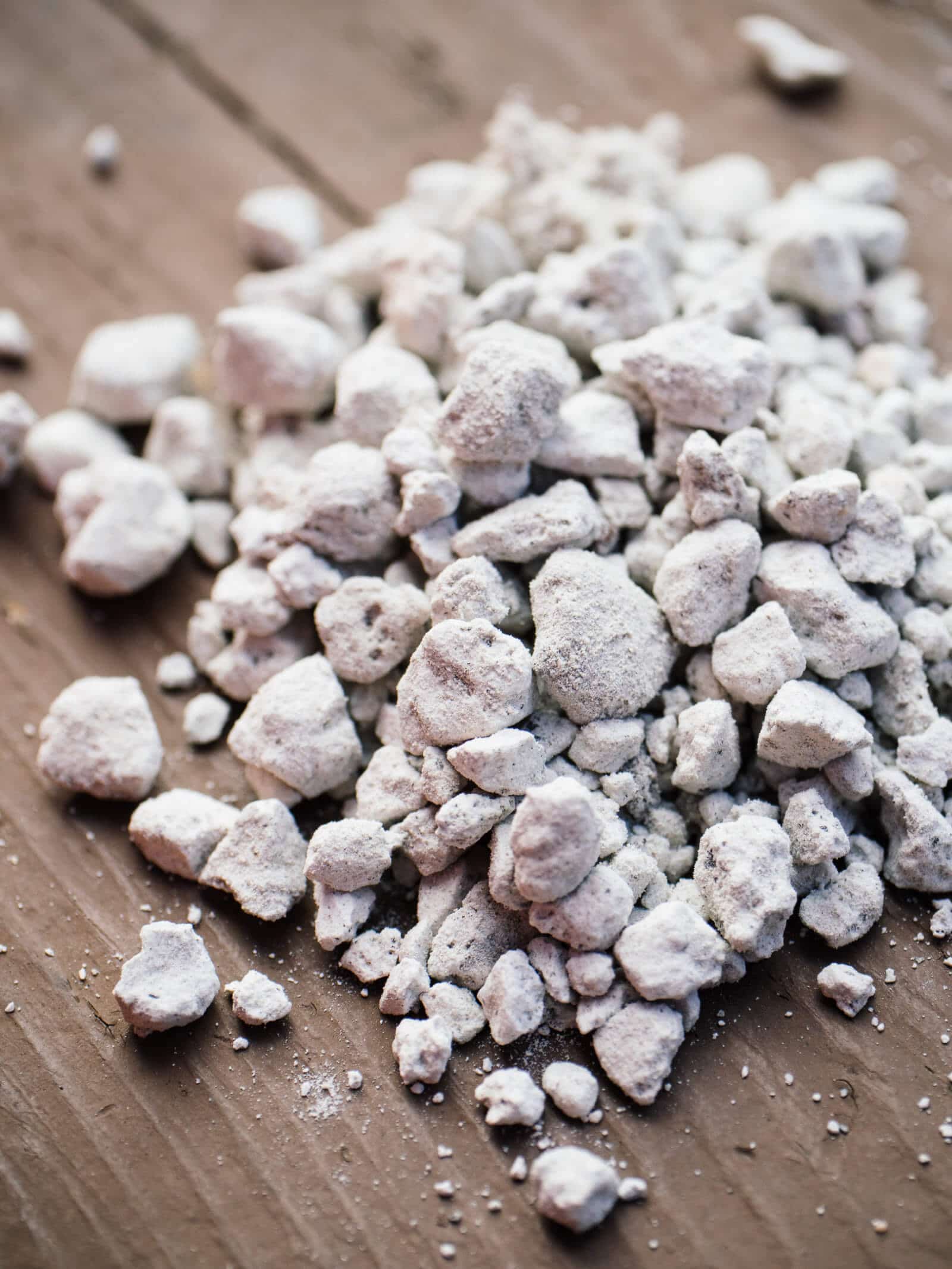
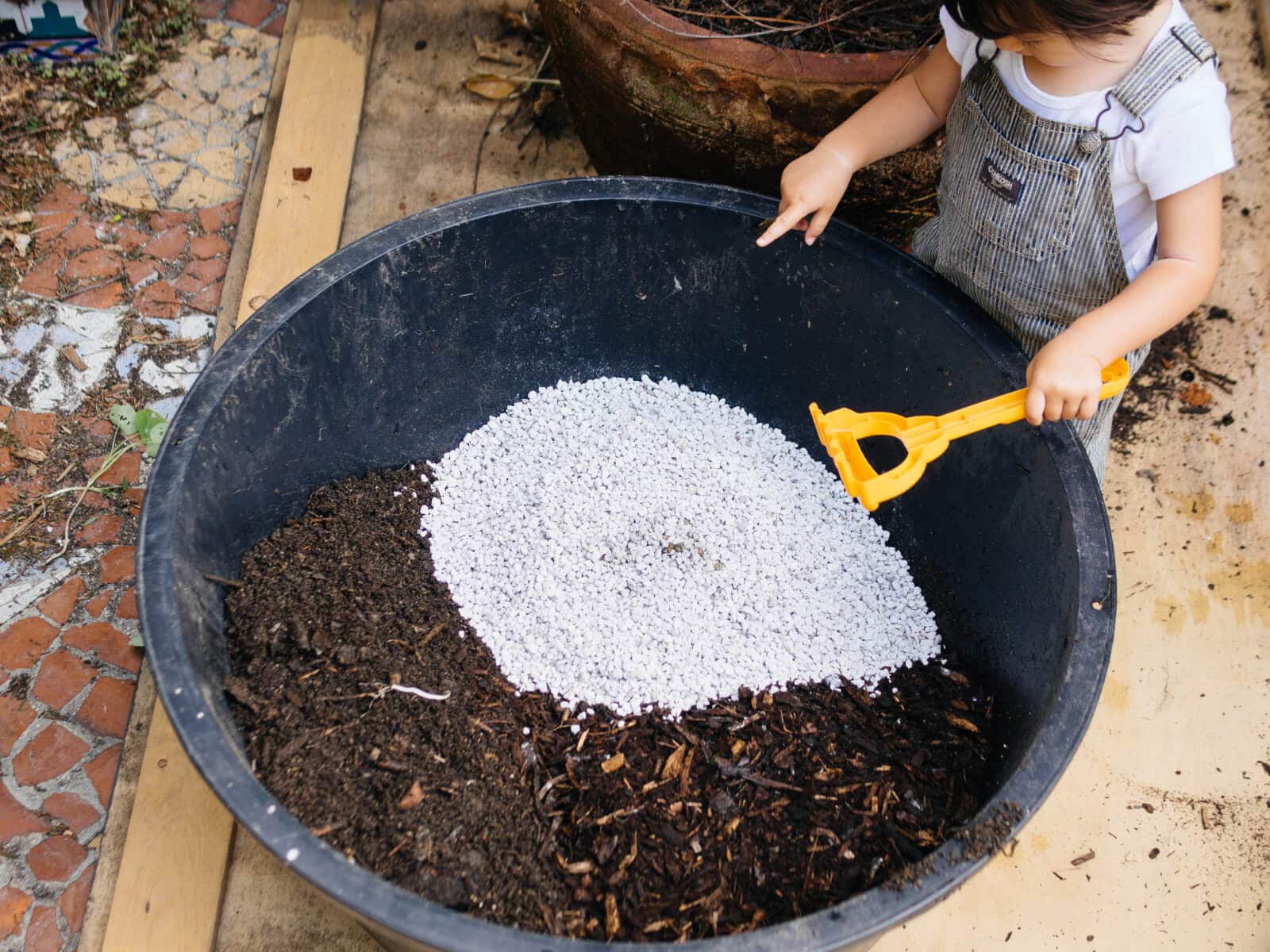
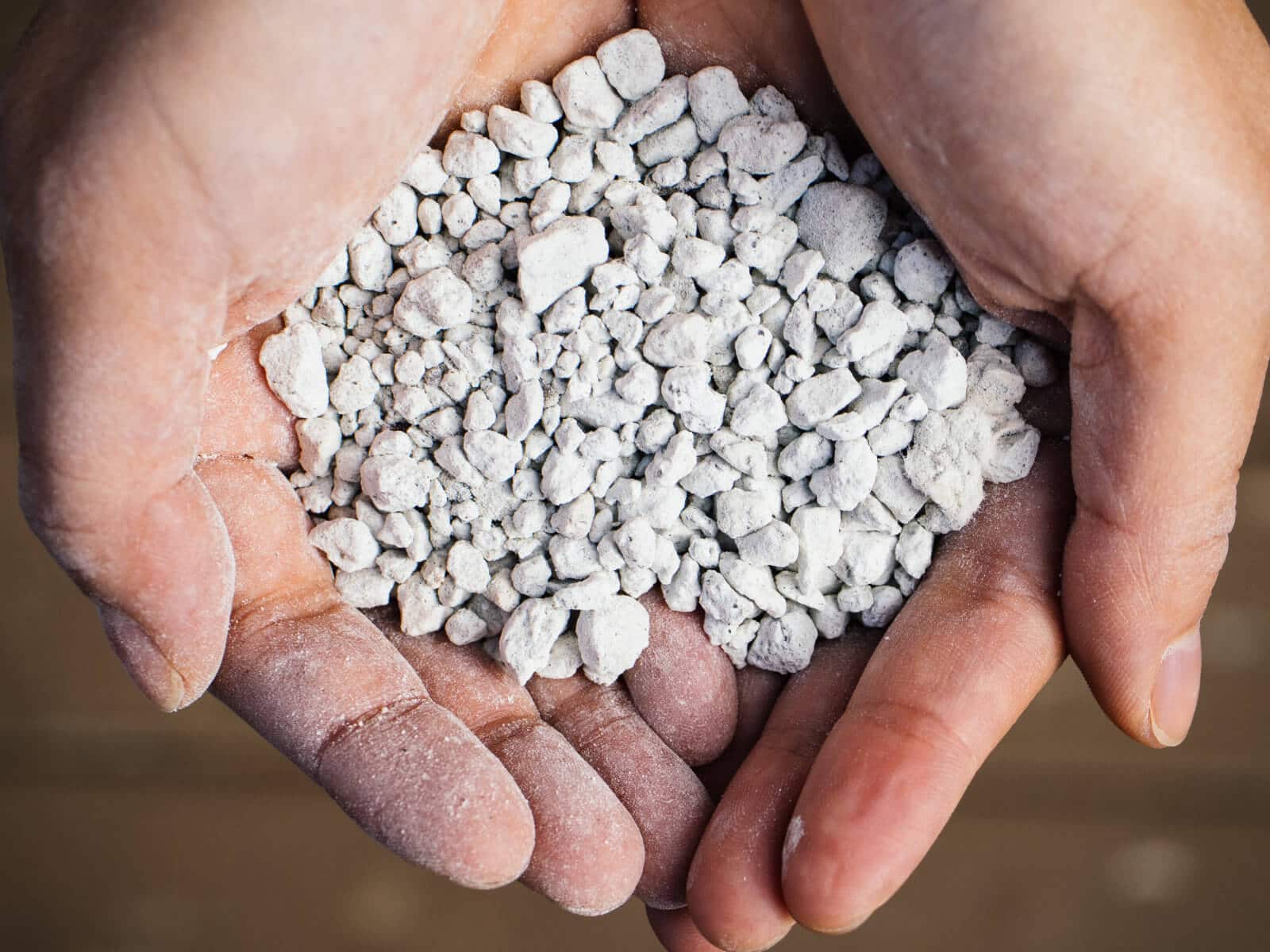













Oh my goodness! This is the best, well-written and comprehensive information on using perlite to amend my clay soil. I will also be utilizing cover crops and compost.. Thank you!
organics break down in the soil…..over time this causes compaction in potting mixes = slumping…..this slumping robs the mix of its oxygen holding abilities,…..which is essential for the roots to breath…..its important to cover the drainage holed in pots so the mix doesnt wash out….that further causes the mix to sink in the pot…..I use gutter guard mesh to cover the holes………Dont put gravel /stones /bark at the bottom of the pot to improve drainage…..Thats a myth…….your mix needs to be uniform in its make up through out the mix…..by adding perlite ..its inorganic and doesnt break down and contains air pockets…so not only does it help with oxygenation of the roots….it prevent compaction of the media as the organics break down……it also helps keep the pot lighter via the mix as well….i use it for growing citrus/mangos and avos in pots …they all hate wet feet.
Sounds like Ficlaybea should go out to their garden get rid of the extra waste built up in their system
Thank you for the info! I have clay soil and a giant bag of perlite and I couldn’t figure out how to properly combine the two. Now I can get that big bag of perlite out of the way in my garage. 🙂
you should be adding compost and gypsum to your soil to help break up the clay first.
Same!
What makes perlite hard? I had some turn hard on top of a plant I recently put outside on my porch I share with other neighbors. It was freshly planted so I had not watered much yet. There seemed to be much more perlite on top than I remembered and little or no soil mixed in with it. I did make the mix strong on perlite as I was attempting to propagate a Zebra plant my 1st time. I’m a novice plant person (obviously, I’m sure) altho my Mother was amazing. Thanks for all your lovely advice!
as a general rule is it a good idea to add a layer of perlite or pumice to regular indoor household plants? Succulent? Like sometimes you see them covered in it. I just started awakening my love for plants and want to make sure I’m doing it right! Great info here by the way!
Is it safe for pets specially cats????
Perlite isn’t a soil amendment so called “GARDEN BETTY” REEEEEEEEEEEEEEEEEE
Perlite is used to amend the soil, so I beg to differ.